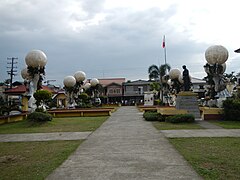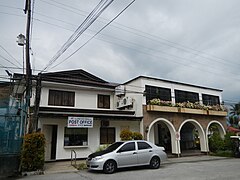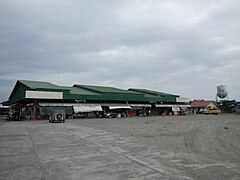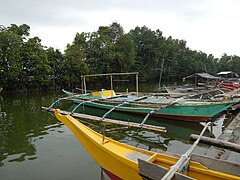Samal, Bataan
Samal | |
|---|---|
| Municipality of Samal | |
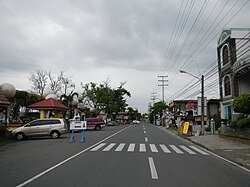 | |
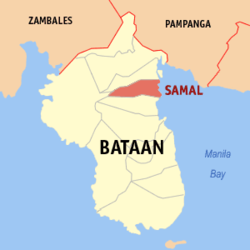 Map of Bataan with Samal highlighted | |
Location within the Philippines | |
| Coordinates: 14°46′04″N 120°32′35″E / 14.76778°N 120.54306°E | |
| Country | Philippines |
| Region | Central Luzon |
| Province | Bataan |
| District | 1st district |
| Founded | 1699 |
| Barangays | 14 (see Barangays) |
| Government | |
| • Type | Sangguniang Bayan |
| • Mayor | Alexander C. Acuzar |
| • Vice Mayor | Ronald M. Ortiguerra |
| • Representative | Geraldine B. Roman |
| • Municipal Council | Members |
| • Electorate | 29,669 voters (2022) |
| Area | |
| • Total | 56.30 km2 (21.74 sq mi) |
| Elevation | 15 m (49 ft) |
| Highest elevation | 133 m (436 ft) |
| Lowest elevation | 0 m (0 ft) |
| Population (2020 census)[3] | |
| • Total | 38,302 |
| • Density | 680/km2 (1,800/sq mi) |
| • Households | 9,185 |
| Economy | |
| • Income class | 4th municipal income class |
| • Poverty incidence | 7.27 |
| • Revenue | ₱ 168.8 million (2020) |
| • Assets | ₱ 295.9 million (2020) |
| • Expenditure | ₱ 169.2 million (2020) |
| • Liabilities | ₱ 141.2 million (2020) |
| Service provider | |
| • Electricity | Peninsula Electric Cooperative (PENELCO) |
| Time zone | UTC+8 (PST) |
| ZIP code | 2101 |
| PSGC | |
| IDD : area code | +63 (0)47 |
| Native languages | Mariveleño Tagalog |
Samal, officially the Municipality of Samal (Tagalog: Bayan ng Samal), is a 4th class municipality in the province of Bataan, Philippines. According to the 2020 census, it has a population of 38,302 people.[3]
Samal is 11 kilometres (6.8 mi) from Balanga and 113 kilometres (70 mi) from Manila. It has a total land area of 56.30 square kilometres (21.74 sq mi).
Etymology[edit]
Samal originated from samel, a covering attached to a banca to protect the passengers from the sun and rain, made of nipa leaves and woven together.
History[edit]
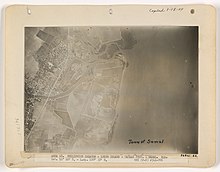
Saint Catherine of Sienna became the patron of Samal, which was founded as a municipality on April 20, 1641.[5]
"Sea gypsies" of Mindanao settlers ("Badjaos" who resided for many years in Maubac, Lambayung, Tanjung, Pata, Tapul, Lugus, Bangos, Pagasinan, Parang, Maimbung, Karugdung and Talipaw, Mindanao) migrated to Luzon in the early 14th century and settled in Bataan. In Samal, they propagated the pearl and capiz culture.
Samal was the second town founded by the Dominican friars in Bataan and is composed of four barrios: Calaguiman, Santa Lucia, Poblacion and Lalawigan.
Geography[edit]
Samal is located in the eastern part of Bataan Peninsula, bordering Abucay to the south, Orani to the north and northwest, Morong to the west, and Manila Bay to the east.
According to the Philippine Statistics Authority, the municipality has a land area of 56.30 square kilometres (21.74 sq mi) [6] constituting 4.10% of the 1,372.98-square-kilometre- (530.11 sq mi) total area of Bataan.
Climate[edit]
| Climate data for Samal, Bataan | |||||||||||||
|---|---|---|---|---|---|---|---|---|---|---|---|---|---|
| Month | Jan | Feb | Mar | Apr | May | Jun | Jul | Aug | Sep | Oct | Nov | Dec | Year |
| Mean daily maximum °C (°F) | 31 (88) |
32 (90) |
34 (93) |
35 (95) |
33 (91) |
31 (88) |
29 (84) |
29 (84) |
29 (84) |
29 (84) |
30 (86) |
31 (88) |
31 (88) |
| Mean daily minimum °C (°F) | 19 (66) |
19 (66) |
20 (68) |
23 (73) |
25 (77) |
25 (77) |
24 (75) |
25 (77) |
25 (77) |
24 (75) |
23 (73) |
20 (68) |
23 (73) |
| Average precipitation mm (inches) | 7 (0.3) |
8 (0.3) |
14 (0.6) |
26 (1.0) |
127 (5.0) |
210 (8.3) |
263 (10.4) |
272 (10.7) |
218 (8.6) |
114 (4.5) |
46 (1.8) |
21 (0.8) |
1,326 (52.3) |
| Average rainy days | 4.0 | 4.0 | 6.9 | 11.2 | 21.0 | 24.5 | 27.4 | 26.9 | 25.9 | 21.9 | 13.4 | 6.3 | 193.4 |
| Source: Meteoblue (modeled/calculated data, not measured locally)[7] | |||||||||||||
Barangays[edit]
Samal is politically subdivided into 14 barangays.[8] Each barangay consists of puroks and some have sitios.
| PSGC | Barangay | Population | ±% p.a. | |||
|---|---|---|---|---|---|---|
| 2020[3] | 2010[9] | |||||
| 030812001 | East Calaguiman (Poblacion) | 6.7% | 2,573 | 2,744 | −0.64% | |
| 030812002 | East Daang Bago (Poblacion) | 3.1% | 1,169 | 1,195 | −0.22% | |
| 030812013 | Gugo | 9.8% | 3,756 | 2,965 | 2.39% | |
| 030812003 | Ibaba (Poblacion) | 8.4% | 3,210 | 3,153 | 0.18% | |
| 030812004 | Imelda | 7.0% | 2,665 | 2,324 | 1.38% | |
| 030812005 | Lalawigan | 10.3% | 3,926 | 3,799 | 0.33% | |
| 030812006 | Palili | 5.5% | 2,092 | 1,865 | 1.16% | |
| 030812008 | San Juan (Poblacion) | 11.0% | 4,230 | 4,089 | 0.34% | |
| 030812009 | San Roque (Poblacion) | 3.0% | 1,159 | 1,154 | 0.04% | |
| 030812010 | Santa Lucia | 6.5% | 2,480 | 2,459 | 0.09% | |
| 030812011 | Sapa | 9.6% | 3,682 | 3,407 | 0.78% | |
| 030812012 | Tabing Ilog | 5.7% | 2,184 | 2,121 | 0.29% | |
| 030812014 | West Calaguiman (Poblacion) | 3.7% | 1,419 | 1,449 | −0.21% | |
| 030812015 | West Daang Bago (Poblacion) | 2.0% | 753 | 854 | −1.25% | |
| Total | 38,302 | 33,578 | 1.32% | |||
Demographics[edit]
|
|
| ||||||||||||||||||||||||||||||||||||||||||||||||||||||
| Source: Philippine Statistics Authority[10][9][11][12] | ||||||||||||||||||||||||||||||||||||||||||||||||||||||||
In the 2020 census, Samal had a population of 38,302.[3] The population density was 680 inhabitants per square kilometre (1,800/sq mi).
Economy[edit]

Graphs are unavailable due to technical issues. There is more info on Phabricator and on MediaWiki.org. |
Composed largely of uplands and hills with some lowlands and plains, Samal's main produce are palay, corn, vegetable, fruits rootcrops, coffee and cutflowers, including livestock, poultry and aquatic resources such as shellfish, crabs, prawns, shrimps and different species of fish.
Joaquin Ma. Joson of Bataan established the first ice plant. Wooden shoe (bakya) making, and pulp mills (Bataan Pulp and Paper Mills, Inc. in the scenic slope of Mount Natib) are some of the industries of the natives. It also manufactures banana chips and arrow root flour through native processes, then made into cookies called araro as pasalubong. Samal is also rich is marine aquatic resources and highly productive farmlands.
Garments manufacturing in Samal is engaged in by five (5) firms already engaged in exports.[vague][20]
In the Town Hall of Samal and along the streets, Capiz shells are displayed to show that the town residents manufacture this commodity.
Government[edit]
Local government[edit]

Pursuant to the Local government in the Philippines",[21][22] the political seat of the municipal government is located at the Municipal Hall. In the History of the Philippines (1521–1898), the Gobernadorcillo was the Chief Executive who held office in the Presidencia. During the American rule (1898–1946) (History of the Philippines (1898-1946)), the elected Mayor and local officials, including the appointed ones held office at the Municipal Hall. The legislative and executive departments perform their functions in the Sangguniang Bayan (Session Hall) and Municipal Trial Court, respectively, and are located in the Town Hall.
Elected officials[edit]
| Position | Name of official |
|---|---|
| District Representative (1st Legislative District, Bataan) | Geraldine B. Roman |
| Municipal Mayor | Alexander Carpio Acuzar |
| Municipal Vice Mayor | Ronald Medina Ortiguerra |
| Municipal Councilors | Marjun Q. Bantay |
| Lolito S. Llanda | |
| Erval V. Flores | |
| Kathrina A. Saldaña | |
| Dylan M. House | |
| Evangeline G. Buensuceso | |
| Edgardo I. De Leon | |
| Jaime M. Manguiat |
Samal's elected officials are - Mayor Alexander Carpio Acuzar (Liberal) and Vice Mayor Ronald Medina Ortiguerra (Liberal).
The Sangguniang Bayan Members are: Marjun Q. Bantay, Lolito S. Llanda, Erval V. Flores, Kathrina A. Saldaña, Dylan M. House, Evangeline G. Buensuceso, Edgardo I. De Leon and Jaime M. Manguiat.[20] They hold office at the second floor of the Town Hall, particularly the Office of the Mayor and Sangguniang Bayan Session Hall, respectively.
The 2nd Municipal Circuit Trial Court of Orani-Samal MCTC Judge Ma. Cristina J. Mendoza-Pizzaro holds office in her sala located at the second floor of the MTC building at the back of the Orani Town hall.
Tourism[edit]
Samal's attractions, events and historical landmarks include:
- Senakulo sa Calaguiman during Holy Week
- Town Hall of Samal
- Samal Capiz shell industry
- Fish ponds, mangrove, mussels and seafoods in Samal bay
- Samal Church
Gallery[edit]
-
Jose Rizal Samal Park and Plaza
-
Post office, rear facade of Town hall
-
Public market
-
Capiz shells street lights surround downtown
-
Banca transportation
References[edit]
- ^ Municipality of Samal | (DILG)
- ^ "2015 Census of Population, Report No. 3 – Population, Land Area, and Population Density" (PDF). Philippine Statistics Authority. Quezon City, Philippines. August 2016. ISSN 0117-1453. Archived (PDF) from the original on May 25, 2021. Retrieved July 16, 2021.
- ^ a b c d Census of Population (2020). "Region III (Central Luzon)". Total Population by Province, City, Municipality and Barangay. Philippine Statistics Authority. Retrieved 8 July 2021.
- ^ "PSA Releases the 2018 Municipal and City Level Poverty Estimates". Philippine Statistics Authority. 15 December 2021. Retrieved 22 January 2022.
- ^ "Official Website of the Municipality of Samal Province of Bataan - MUNICIPAL PROFILE". Archived from the original on 2014-04-23. Retrieved 2013-01-23.
- ^ "Province: Bataan". PSGC Interactive. Quezon City, Philippines: Philippine Statistics Authority. Retrieved 12 November 2016.
- ^ "Samal: Average Temperatures and Rainfall". Meteoblue. Retrieved 26 April 2020.
- ^ "Municipal: Samal, Bataan". PSGC Interactive. Quezon City, Philippines: Philippine Statistics Authority. Retrieved 8 January 2016.
- ^ a b Census of Population and Housing (2010). "Region III (Central Luzon)" (PDF). Total Population by Province, City, Municipality and Barangay. National Statistics Office. Retrieved 29 June 2016.
- ^ Census of Population (2015). "Region III (Central Luzon)". Total Population by Province, City, Municipality and Barangay. Philippine Statistics Authority. Retrieved 20 June 2016.
- ^ Censuses of Population (1903–2007). "Region III (Central Luzon)". Table 1. Population Enumerated in Various Censuses by Province/Highly Urbanized City: 1903 to 2007. National Statistics Office.
{{cite encyclopedia}}: CS1 maint: numeric names: authors list (link) - ^ "Province of Bataan". Municipality Population Data. Local Water Utilities Administration Research Division. Retrieved 17 December 2016.
- ^ "Poverty incidence (PI):". Philippine Statistics Authority. Retrieved December 28, 2020.
- ^ "Estimation of Local Poverty in the Philippines" (PDF). Philippine Statistics Authority. 29 November 2005.
- ^ "2003 City and Municipal Level Poverty Estimates" (PDF). Philippine Statistics Authority. 23 March 2009.
- ^ "City and Municipal Level Poverty Estimates; 2006 and 2009" (PDF). Philippine Statistics Authority. 3 August 2012.
- ^ "2012 Municipal and City Level Poverty Estimates" (PDF). Philippine Statistics Authority. 31 May 2016.
- ^ "Municipal and City Level Small Area Poverty Estimates; 2009, 2012 and 2015". Philippine Statistics Authority. 10 July 2019.
- ^ "PSA Releases the 2018 Municipal and City Level Poverty Estimates". Philippine Statistics Authority. 15 December 2021. Retrieved 22 January 2022.
- ^ a b "Municipality of Samal". Archived from the original on 2013-03-11. Retrieved 2013-01-23.
- ^ "the 1987 Constitution of the Republic of the Philippines". Official Gazette of the Republic of the Philippines. Archived from the original on 22 January 2009. Retrieved 19 January 2021.
- ^ "The Local Government Code Of The Philippines - Chan Robles Virtual Law Library". Chanrobles.com. Retrieved 2016-11-21.





